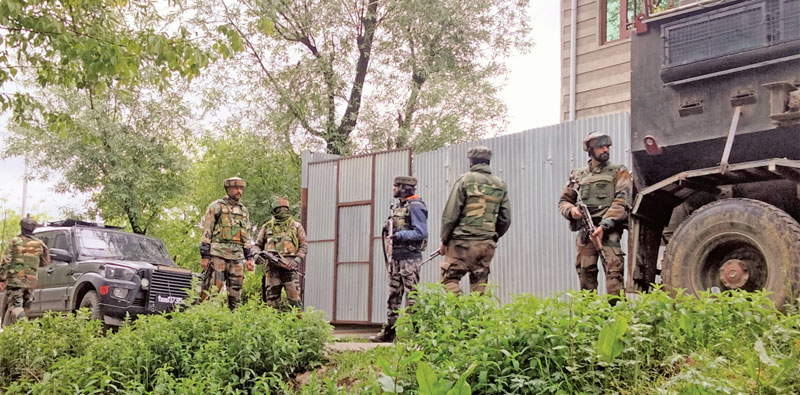Time for India to have an exclusive force for internal security relieving RR
 S.K. Sood
S.K. Sood
The impunity with which militants have carried out about a dozen attacks on army patrols and posts in Jammu region in the past last 90 days, besides raising serious questions about the overall strategy of the government in controlling militancy, raises serious questions about the planning and actual execution of these plans by the defence forces in controlling militancy in the area. Militants appear to have lot of places available to manoeuvre and regroup for action against security forces due to thinning out of troops caused by the withdrawal and diversion of Rashtriya Rifle (RR) units for deployment along the line of actual control (LAC) on the northern borders with China. This, coupled with very little deployment in remote areas, enables militants to carry out attacks and withdraw to hideouts in these places.
The Army whose primary role is to defend the nation and its territorial integrity against external threats, got involved to combating several insurgencies and militancy in the early years after independence. Initially, it was because other trained forces were not available for the task and the problems were beyond the capability of the police. With the raising of several central armed forces and their large-scale expansion over the years, the Indian Army should logically have been relieved from these tasks and sent to the borders. However, this did not happen, and the Indian Army continues to be deployed for anti-militancy operations in Jammu and Kashmir (J&K) for the last 35 years.
It is beyond question that the diversion of defence forces from their primary task to fight militancy/internal security problems should only be as a last resort because it is at the cost of defence preparedness. Deployment of the Indian Army for a prolonged period for internal security tasks is not in the interest of national security as it leads to degradation of their war-fighting capabilities. The Indian Army is not ab initio trained for the task of handling internal security. Nor is it legally empowered to carry out independent operations, especially in those areas where the armed forces special power act (AFPSA) has not been promulgated. In fact, the lack of such legal backing is a major problem that the security forces are facing in controlling the conflict in Manipur. These are valid points and are rightly advanced by the Indian Army for resisting deployment in Maoist-affected central India and other insurgency affected areas.
Another big factor likely to adversely impact the capabilities of defence forces both in war and the internal security environment is the Agnipath scheme introduced in 2022. During my interactions with many serving and retired defence forces personnel of different ranks, the constant refrain was that Agniveers are not suitable for the Army. It was repeatedly stated that the Agniveers lacked adequate motivation because of the uncertainty about their future and also because they felt discriminated on account of salary and the compensatory package, etc. By now a large number of Agniveers have joined the Indian Army and have been posted to different units. Some of these units would also be deployed in anti-militancy duties.
The anti-militancy operations generally are small team operations where individual initiative and quick reflexes are extremely important. The commanders therefore will find it very difficult to adjust an inadequately trained and motivated Agniveer into their plan of operations thereby degrading their capabilities even in these tasks. An ill-motivated Agniveer not seeped in the ethos of ‘Naam, Namak and Nishan’ will probably be the first to abandon his comrade in the eventuality of coming under fire from militants. Another issue is that with only 25 per cent of them to be retained, the Agniveers may resort to sycophancy to impress their superiors. This will have an adverse impact on the camaraderie and team spirit which is likely to compromise operational performance.

Having realised the importance of keeping the Army war ready and ensuring that its warfighting abilities are not adversely impacted, a new force called Rashtriya Rifles was raised as a counter-insurgency/ counter-terrorism force in 1990, to specifically serve in the J&K region. The RR also maintains public order by drawing powers from the Armed Forces (Jammu and Kashmir) Special Powers Act, 1990. The RR was raised by the Indian Army by reconstituting two corps (about 75,000 troops). Its personnel are provided by the Indian Army on deputation. Thus, RR battalions were raised by pooling in soldiers from different arms and services. They were put through specialised training for this task. Regular turnover of troops after three to four years in the RR ensured that troops did not suffer from fatigue, besides ensuring that the profile of troops always remained young. The RR has performed fairly well in the anti-militancy role in J&K. However, since the troops were drawn from different arms and services, it took time for the troops and commanders to know each other which is essential for carrying out successful operations. A moot point is that diversion of a large force strength equal to two corps has led to deficiency of troops for deployment in forward areas. The problem of deficiency of troops is further aggravated by absence of fresh recruitment from about 2019 onwards. The deficiency ihas critical impact in the present operational environment prevailing on the northern borders where the aggressive posture of China has compelled India also to deploy large strength in forward positions. The decision, therefore, to withdraw RR units from anti-militancy roles and deploy them on the LAC instead of infantry units appears strange.
The question therefore is whether the Indian Army should be withdrawn from all internal security duties including J&K? The answer is yes because of the requirement of troops for deployment along the northern borders with China, especially in Ladakh, Sikkim and Arunachal Pradesh. Further, with the by the strategic community, it is desirable that the entire component of the Indian Army is readily available in the shortest time frame in order to meet any eventuality.
That brings us to the question of who should take on the responsibility of anti-militancy tasks in the valley. Should the Central Armed Police Forces (CAPF) be tasked exclusively for this in addition to their deployment in other parts of the country or a force exclusively trained for this purpose be raised?
An alternative is to hand over the anti-militancy operation in J&K exclusively to RR. However, it is not a desirable proposition because as stated, the troops for RR have been pooled out from the army, depleting its fighting strength. The RR should actually be disbanded, and troops sent to their parent units in order to make up the strength depleted because of the deputation of troops to various RR units.
Notwithstanding a few setbacks, the CAPF have performed very well in tackling insurgency and militancy in different parts of the country. They had played a major role in controlling militancy in Punjab along with Punjab police. Their role in handling militancy in J&K has also been commendable.
So, should the CAPF be exclusively deployed for anti-militancy/anti-insurgency role?
In order to understand the complexity involved in complete withdrawal of the Army and takeover of the internal security situation by CAPF, it is essential to understand the genesis of these forces. Periodic review of the security scenario by successive governments has led to the raising of several armed forces controlled directly by the union government. Each CAPF was raised in response to a specific security threat that arose from time to time.
Central Reserve Police Force (CRPF) which is a pre-independence entity, was tasked with assisting the civil authorities in maintaining law and order and internal security. Central Industrial Security Force (CISF) was raised for industrial security while Indo-Tibetan Border Police (ITBP), Border Security Force (BSF) and Sashashtra Seema Bal (SSB) were raised to guard the borders with Tibet, Pakistan, Nepal and Bhutan respectively. However, all these forces have often had to be diverted from their main task for internal security.
Keeping in view the importance of border security and its impact on internal security, the committee of group of ministers (GOM) set up after the Kargil War to review the security scenario in the country enunciated the principle of One Task One Force. It recommended that the border guarding forces should remain focussed on guarding the borders and should not be generally utilised for internal security. The GOM designated CRPF as the internal security force for the country. However, despite a large expansion of CRPF, the government is compelled to employ the border guarding forces besides the resources of state governments for deployment in militancy and insurgency prone areas because of the plethora of problems being faced by the country and the heavy requirement of troops to tackle these.
You must be logged in to view this content.

